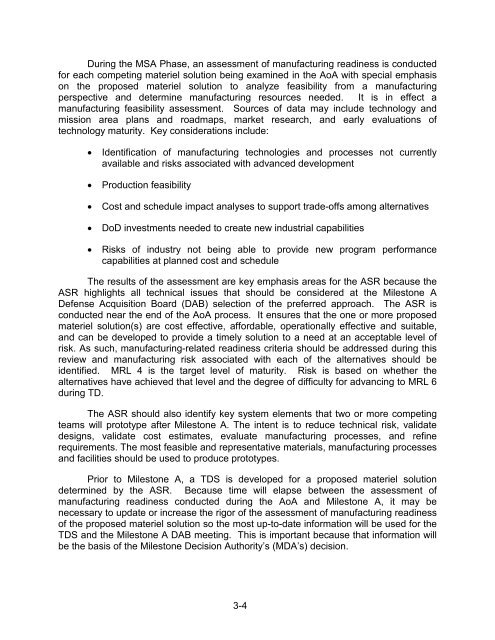Manufacturing Readiness Level (MRL) Deskbook
Manufacturing Readiness Level (MRL) Deskbook
Manufacturing Readiness Level (MRL) Deskbook
- No tags were found...
Create successful ePaper yourself
Turn your PDF publications into a flip-book with our unique Google optimized e-Paper software.
During the MSA Phase, an assessment of manufacturing readiness is conductedfor each competing materiel solution being examined in the AoA with special emphasison the proposed materiel solution to analyze feasibility from a manufacturingperspective and determine manufacturing resources needed. It is in effect amanufacturing feasibility assessment. Sources of data may include technology andmission area plans and roadmaps, market research, and early evaluations oftechnology maturity. Key considerations include:• Identification of manufacturing technologies and processes not currentlyavailable and risks associated with advanced development• Production feasibility• Cost and schedule impact analyses to support trade-offs among alternatives• DoD investments needed to create new industrial capabilities• Risks of industry not being able to provide new program performancecapabilities at planned cost and scheduleThe results of the assessment are key emphasis areas for the ASR because theASR highlights all technical issues that should be considered at the Milestone ADefense Acquisition Board (DAB) selection of the preferred approach. The ASR isconducted near the end of the AoA process. It ensures that the one or more proposedmateriel solution(s) are cost effective, affordable, operationally effective and suitable,and can be developed to provide a timely solution to a need at an acceptable level ofrisk. As such, manufacturing-related readiness criteria should be addressed during thisreview and manufacturing risk associated with each of the alternatives should beidentified. <strong>MRL</strong> 4 is the target level of maturity. Risk is based on whether thealternatives have achieved that level and the degree of difficulty for advancing to <strong>MRL</strong> 6during TD.The ASR should also identify key system elements that two or more competingteams will prototype after Milestone A. The intent is to reduce technical risk, validatedesigns, validate cost estimates, evaluate manufacturing processes, and refinerequirements. The most feasible and representative materials, manufacturing processesand facilities should be used to produce prototypes.Prior to Milestone A, a TDS is developed for a proposed materiel solutiondetermined by the ASR. Because time will elapse between the assessment ofmanufacturing readiness conducted during the AoA and Milestone A, it may benecessary to update or increase the rigor of the assessment of manufacturing readinessof the proposed materiel solution so the most up-to-date information will be used for theTDS and the Milestone A DAB meeting. This is important because that information willbe the basis of the Milestone Decision Authority’s (MDA’s) decision.3-4
















